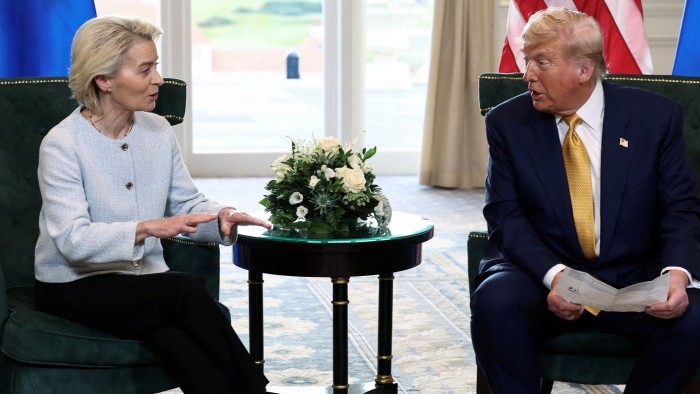Unlock the Editor’s Digest for free
Roula Khalaf, Editor of the FT, selects her favourite stories in this weekly newsletter.
The EU on Tuesday said it would suspend its retaliatory tariffs on the US even as the specifics of a trade deal reached last month, including lower tariffs on European cars, have yet to be signed off by Donald Trump.
The US president last week signed an executive order that will implement as of Friday a 15 per cent tariff rate on most EU products, which European Commission President Ursula von der Leyen agreed to when the two leaders met in Scotland at the end of July.
The bloc had readied higher levies on €93bn worth of US exports, which were due to enter into force as of Thursday had trade talks failed.
“The suspension [of retaliatory tariffs] is a reflection of the fact that a political agreement has been reached,” said a senior EU official, noting that both sides were now implementing that deal. The official added that the retaliatory measures were now being “put back into the freezer and we can always take it out if needed”.
Washington and Brussels are still negotiating the text of a joint statement which was expected soon after Trump and von der Leyen shook hands in Scotland. Clarity is still lacking on when the US will lower its 27.5 per cent rate on European cars to 15 per cent — a key export sector for Germany — as well as the categories of products that will be traded at zero tariffs.
“We worked very hard to ensure we have that immediate tariff relief also for cars. We are working hard to see that in practice,” said the EU official.
One aspect yet to be agreed is how to treat EU car parts that come from outside the bloc, particularly from China.
The EU official said that “there might be further ways to restrict content from certain non-market economies”, adding that negotiations are ongoing.
As for the zero-tariff exemption, the EU is still pushing for wine and spirits to be included, a key ask from France and Italy — even as Washington has flatly denied they could receive such a carve-out. Brussels is also pushing for chemicals and certain medical devices to be excluded from the 15 per cent rate, but it remains unclear whether it will succeed.
“We’re trying to get as many products into the list of exemptions . . . we have a certain number of sectors where we agree [such as] aircraft and aircraft components,” said the official, while admitting that “not all products that we care to see . . . will be on that list immediately”.
Negotiations are also ongoing on European steel and aluminium exports, currently subject to a 50 per cent rate. The EU is aiming to secure “tariff rate quotas” — meaning lower rates for exports matching what has historically been traded with the US, while accepting higher rates above those thresholds. But US officials have not yet signed off on this concept.
The EU official said there was an “understanding reached at political level” on steel, but that it would “take a little bit more time” to iron out.
A majority of EU countries would eventually have to approve parts of the deal, such as lowering of EU tariffs on certain US exports, but that will only happen “after the final deal” has been agreed, the EU official said.
The EU-US deal was harshly criticised by countries including France and Germany for giving in too much and accepting higher tariffs.
German finance minister Lars Klingbeil on Monday said that the EU had been “too weak” in negotiations with the US and that Germany “can’t be satisfied with the result that was achieved”.
The commission, which negotiates trade deals on behalf of the bloc, pushed back on Tuesday saying that it was “most surprising . . . given that nothing has happened here . . . without the clear signal received from our member states”.
Officials also pointed out that the agreement averted an all-out trade war and Washington making good on its threat of pulling its security guarantees from Europe. Von der Leyen’s trade agreement includes investment pledges and more purchases of US weapons and energy products.
“We chose the less bad option and we feel this is the better choice,” said the EU official. “We’re very clearly operating in a second best world.”



